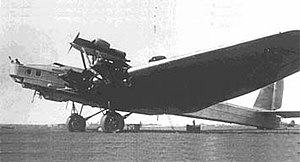Tupolev ANT-16
| ANT-16 (TB-4) | |
|---|---|
 |
|
| Role | Heavy bomber |
| National origin | Soviet Union |
| Manufacturer | Tupolev |
| First flight | 3 July 1933 |
| Status | Retired |
| Primary user | Soviet Union |
| Number built | One |
| Developed from | Tupolev TB-3 |
| Variants | ANT-20 |
TheTupolev ANT-16 (also known as the TB-4; Russian: Тяжелый Бомбардировщик – Heavy Bomber) was an experimental heavy bomber aircraft designed and tested in the Soviet Union in the early 1930s. Conceptually representing evolution of the TB-3 bomber, the ANT-16 was designed under the doctrine that size and payload were more important for a bomber than speed because it would be able to protect itself with defensive armament. The twin 5 by 1.8 by 1.8 metres (16.4 ft × 5.9 ft × 5.9 ft) × 16.5 by 5.11 by 5.11 feet (5.03 m × 1.56 m × 1.56 m) bomb bays were the largest in the world at that time and presented many design challenges in order to preserve structural rigidity of the airframe.
The sole prototype first flew on 3 July 1933 with M. M. Gromov at the controls. The test flight program was completed by 29 September 1933 with disappointing results. The two top-mounted engines performed poorly and a significant portion of thrust generated by the wing-mounted engines was absorbed by the two meter-thick (6 ft 7 in) wing. A proposal to re-equip the aircraft with Mikulin AM-35 engines of 933 kW (1,250 hp) was not implemented.
Data from Shavrov 1985
General characteristics
Performance
Armament
...
Wikipedia
